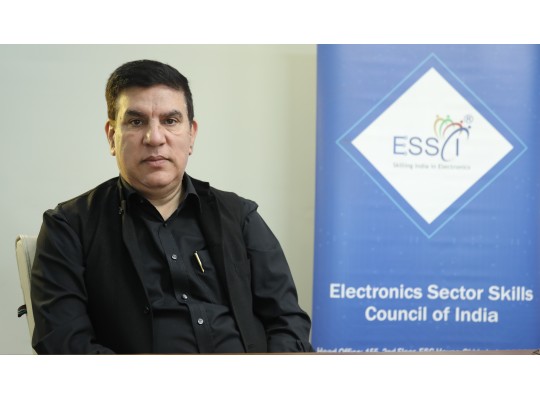As India takes major steps to establish itself as a global semiconductor manufacturing hub, aligning this growth with sustainable practices has become crucial. India is making significant strides in becoming a global hub for semiconductor manufacturing. As of 2023, India ranks 39th in global semiconductor readiness, reflecting its growing capabilities in this sector. The country has ambitious plans to expand its presence, aiming to capture at least 10% of the global semiconductor market by 2030. Semiconductor manufacturing, while essential for technological advancement, is resource-intensive, involving significant water and energy consumption, emissions, and waste. Addressing these environmental impacts is vital for India to maintain a competitive edge and achieve its ambitious sustainability goals.
India’s Semiconductor Push and Environmental Challenges
Semiconductor manufacturing relies heavily on energy and water, with fabs consuming millions of metric tons of water and high levels of energy annually. As India aims to increase domestic semiconductor production, the environmental impact will rise unless sustainable practices are implemented. Recognizing these challenges, the Indian government has established the India Semiconductor Mission (ISM), with an allocation of ₹76,000 crore (over $10 billion USD) to support semiconductor manufacturing, display fabs, and compound semiconductors, among others. This mission prioritizes creating high-tech clusters with infrastructure for energy and water conservation, aiming to balance economic growth with environmental stewardship.
Strategies for Sustainable Semiconductor Manufacturing in India
1. Energy Efficiency and Renewable Energy Integration: Indian fabs are adopting energy-efficient technologies and shifting to renewable energy sources where feasible. This aligns with the country’s renewable energy targets, including achieving 500 GW of renewable capacity by 2030. The integration of solar panels, microgrids, and energy-efficient lighting in fabs is essential, as India’s power infrastructure faces strain from industrial growth and climate impacts. Collaborative efforts with power suppliers and technology providers are also helping fabs transition to sustainable energy sources.
2. Water Conservation and Recycling: Given the high water requirements for semiconductor fabs, efficient water management has become a priority. Advanced fabs are using recycling systems to treat and reuse up to 75% of their water. In water-scarce areas, particularly in states like Karnataka and Maharashtra where semiconductor manufacturing is developing, such measures are essential to maintain operations sustainably and avoid depleting local water resources.
3. Reducing Carbon Emissions through Advanced Technologies: As fabs work toward lower emissions, they are investing in process-gas abatement systems and alternative materials with lower environmental impacts. In line with India’s commitment to reducing greenhouse gas emissions, fabs are increasingly implementing advanced air and chemical filtration systems. The move toward greener technologies in fabs aligns with India’s broader goal of reducing industrial emissions under its commitments to the Paris Agreement.
4. Supply Chain and Workforce Development: India is making significant progress in building a semiconductor ecosystem that emphasizes local sourcing and reducing dependency on imports, while also strengthening its workforce capabilities. The government has introduced various initiatives, including the Production-Linked Incentive (PLI) scheme, aimed at encouraging the domestic production of semiconductor components.
This initiative is part of India’s broader push to create a more resilient supply chain that not only addresses disruptions but also mitigates emissions related to transportation.
In parallel, efforts to build a skilled workforce are underway, supported by collaborations between industry, academia, and government bodies. Organizations like the Electronics Sector Skills Council of India (ESSCI) play a pivotal role in addressing the skills gap by training workers in semiconductor manufacturing technologies. This will ensure India has the necessary human resources to meet the growing demand for semiconductors in the coming years.
5. Circular Economy Initiatives and E-Waste Management: In line with sustainable growth, India is also focusing on Circular Economy practices and the management of e-waste in the semiconductor industry. The government has launched initiatives like the National E-Waste Management Policy and various state-level e-waste collection programs aimed at encouraging the recycling of semiconductor components and other electronic waste. These policies aim to reduce the sector’s environmental footprint by promoting responsible disposal and recycling of semiconductor materials.
Additionally, the Ministry of Electronics and Information Technology (MeitY) has included circular economy principles in its development strategies, pushing for systems where resources are reused, refurbished, or recycled, which will further support India’s vision of reducing reliance on imports and promoting sustainability. The focus on creating a circular semiconductor ecosystem is expected to create jobs in the recycling and waste management sectors, contributing to India’s economic and environmental goals.
Future Outlook for Sustainable Growth in Semiconductor Manufacturing
India’s sustainability-focused initiatives, such as the ISM and PLI schemes, are integral to supporting a resilient and eco-friendly semiconductor industry. By establishing high-tech clusters and promoting sustainable practices, India is positioning itself to compete in the global semiconductor market while advancing environmental objectives. The continued adoption of energy-saving technologies, water management practices, and circular economy principles will be essential as India scales its semiconductor capabilities. Through these efforts, India aims to make semiconductor manufacturing both a driver of economic growth and a model of sustainability.
India’s commitment to sustainable semiconductor manufacturing underscores its dedication to achieving technological self-reliance, economic growth, and environmental sustainability, establishing a foundation for a responsible and competitive industry.
In conclusion, sustainability in semiconductor manufacturing is no longer optional—it’s a strategic imperative. As India scales its semiconductor capabilities, integrating sustainable practices will ensure that growth aligns with environmental responsibility. This will not only benefit the economy but also help in meeting ambitious environmental goals. According to recent estimates, India’s semiconductor market is projected to grow from $15 billion in 2020 to over $64 billion by 2026, underscoring the need for responsible growth. Initiatives such as the Production-Linked Incentive (PLI) scheme and circular economy policies are vital in minimizing the sector’s environmental footprint, ensuring that this growth remains sustainable in the long term.













